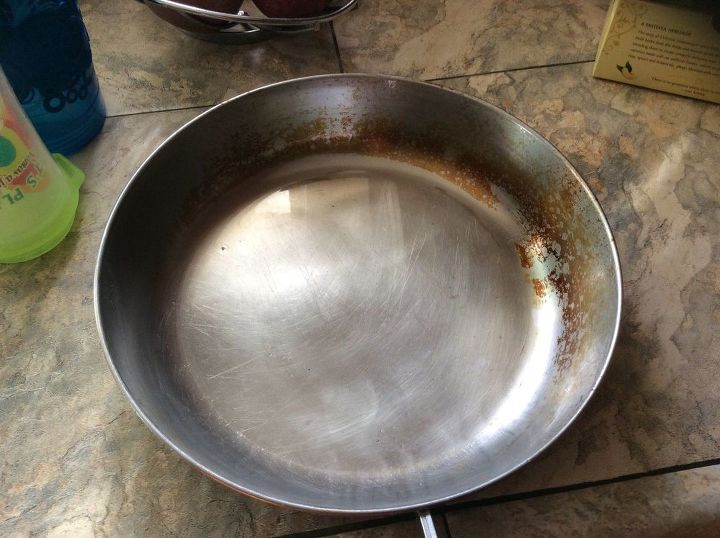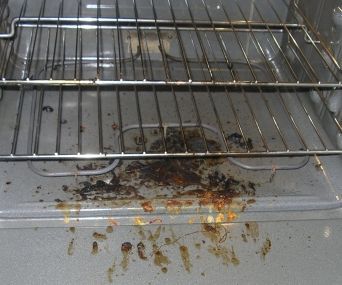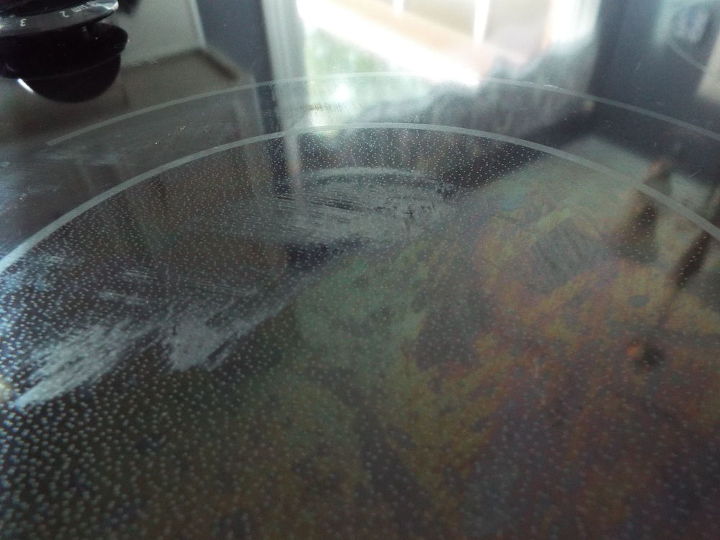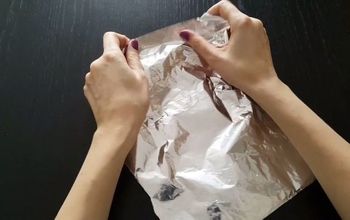How do you clean gunk out between drum and gasket of front load washer
My front load wash machine leaves brown-like grease streaks on clothes that tumble into that area of machine while in a wash cycle. How can I get all that gunk out between to get the washing machine clean? I try to clean with paper towels but too narrow to fit hand in. I do the tub wash and everything else comes out clean except for that. Thanks!
Related Discussions
How to clean a mirror without streaks?
Every time I clean my mirrors, they end up having tons of streaks and almost look worse than before I started. What could I use to clean them that won't leave streaks... See more
How to clean burns on stainless steel pans?
Help! I burned my pan. How do I clean stainless steel cookware that's been burned?
How to clean shower doors
How to clean glass shower doors
How to clean hardwood floors in the kitchen?
What is the best way to clean hardwood floors in the kitchen?
How to clean my kitchen cabinets from grease?
My kitchen cabinets are embarrassingly greasy. Please share your degreasing tips with me so I don't have to cringe every time I glance at my cabinets.
I've had my stove (Maytag) about two years and have never cleaned the
oven. Until recently, it didn't need it. Now it does. I've never had a self-cleaning oven until this one and after quickly reading the instructions, I'm hesitant to t... See more
Can anyone suggest a way to get this off of my glass cook top?
Ok so I moved into my current home a little over a year ago. The cook top was here when we moved in and it has these horrible stains? I have had glass cook tops befor... See more




Why your washing machine smells, and how to clean it
When we think of washing machines, we think of clean, fresh-smelling clothes. Laundry is supposed to have a comforting aroma—one that’s so well-loved that there are even colognes designed to mimic its scent.
But what do you do when your front-load washer, well... stinks?
Before you resign yourself to a musty, mildewy, sour-scented existence, consider this: Your washer probably isn’t defective—it just needs some TLC. A few simple steps could help eliminate that stench forever.
That’s right, my friends: It’s all smooth, fresh-smelling sailing from here on out. Grab your hampers, keep your heads high, and scrub stinky clothes from your life for good.
Why your front-loader stinks
I took an in-depth look at the relative performance of front- and top-load washers, and found that front-loaders are superior in virtually every way. That came as no surprise, since front-loaders are designed not only to be more efficient, but also to be gentler on clothes while cleaning them better.
But it's that efficiency part that can cause some headaches when it comes to smell. See, high-efficiency front-loaders use a lot less water than their top-load counterparts, since they fill just the bottom of the wash tub with water. Since the drum rotates on a horizontal axis, your clothes tumble through the water, eliminating the need to fill the tub up all the way.
That's all fine and dandy if you use high-efficiency detergents, but when you douse your laundry with the wrong kinds of soap and softeners, the smaller amount of water can’t fully rinse them away. The drum ends up getting coated with a layer of soap scum, which is itself peppered with debris and dirt from your clothing. In the heat and damp of your washer, this scum makes a happy home for mildew, bacteria, and mold.
The stinky situation is compounded by the fact that front-load washers use a rubber door gasket to keep water from leaking out. Dirt, soap, and bits of fabric can get trapped under the gasket, creating yet another breeding ground for nasty smells.
How to get rid of that smell
1. Bring out the baking soda.
Your first inclination may be to reach for the bleach, but I prefer to use something a little gentler. I suggest mixing 1/4 cup of baking soda with an equivalent amount of water. Add this solution to your machine’s detergent container.
2. Bring out the vinegar.
Pour two cups of white vinegar into the drum, then run a normal cycle at high heat—without any clothes, of course.
The baking soda and vinegar should break up any residue stuck to your drum and kill any mold that might be present. They’ll also help remove any foul odors.
3. Scrub away any remaining grime.
If stubborn spots remain, attack them with the rough side of a kitchen sponge and a mixture of one part white vinegar, one part water. Ta-dah, good as new!
You can repeat this cleaning method once a month for maintenance if you’d like, or try some other odor prevention techniques.
How to keep your front-loader fresh
Your washer is finally free of nasty odors, and you want to keep it that way. But how?
1. Break up with your old detergent.
If you own a front-loader, you should always use detergents made for high-efficiency machines. Normal detergents simply produce more suds than your front-loader can handle; less suds means less scum for stinky lifeforms to cling to. Liquid fabric softener is also off-limits for front-loading washing machines, so do yourself a favor and ditch it.
2. Keep the drum dry
Once you’ve got the soap situation under control, it’s time to make sure the drum doesn’t stay damp for long periods of time. Always remove your laundry promptly after the cycle ends, and be sure to leave the door open when it’s not in use, so the moisture can escape.
You can also run a fan in the room where your washer lives to improve airflow, and consider investing in a dehumidifier. Remember: You don't want bacteria or mold to feel at home here, and nothing invites bad smells quite like wet, stagnant heat.
3. Clean the gasket.
Even with the correct detergent and anti-humidity efforts, there's no guarantee your washer drum won't develop some mold-friendly buildup. The rubber seal around the doors is especially problematic, so you should regularly remove any debris you see trapped in the gasket and wipe it down with a cleaning solution made of one part white vinegar and one part water.
Finally, be sure to dispose of any lint that may have accumulated in your machine’s drain trap filter. Once a week should do the trick.
Sounds like a job for vinegar!
Thank you! That's pretty much what I do anyway. My only concern is that I cannot reach the gunk that is stuck between the rubber seal & the actual steel drum. 😬 You can only reach so far. It is sooo frustrating. I don't have time for this 🙄Ugh! But I see it there & it drives me crazy!! I'm actually broken a couple nails trying to reach down in there. I've used tweezers. I've used to fix. I've used skewers. To no avail. It just doesn't get it all. In the tub clean definitely doesn't even touch it. Any thoughts? Otherwise I need to call the company. There's got to be an easier way to clean it.
I’ve poked Screwdrivers in there too. I see no answer to this problem, everyone wants to describe cleaning the drum, which is easy!
I managed to do it with my fingers and a wet microfiber cloth. It wasnt easy and I had to do it several times, I was amazed at the gunk in there. Cleaning the door gasket is easy, why is this gasket ignored in all the instructions. Crazy
I am having the same problem in between the rubber gasket and the drum it’s too small to fit a cloth or finger I have tried using paper towels sponges and even ear buds but cannot get out all the gunk it’s driving me crazy because my washing machine smells of mould and mildew I think I’m going to have to buy a new washing machine every body shows videos of cleaning the gasket yes that’s the easy part but in between the gasket and drum is quite impossible to clean arghhhhhh😤😡😫
I have the same problem. I have used q-tips to get some out but here is so much there. I was hoping for more tips!
You made me curious so I took a flashlight and looked at my front loader washer to see if I had mold or black gunk between the gasket and drum. My washer is about four years old and there is not a sign of anything black in that little place between the drum and gasket. Are you ladies leaving the door open between washes all the time? Are you leaving the soap dispenser drawer open between washes all the time? I do wipe the washer out with a towel when I am done washing and my washer is on the first floor near the kitchen. I would call the company and tell them your problem.
Use a hot rinse of one cup vinegar to remove or loosen it and then wipe it down. After doing the laundry, wipe the area dry and then leave the door ajar to dry thoroughly. Use 1/4 cup of vinegar in your rinse water when washing and you will not have a problem since the vinegar cuts the soap suds and makes your clothes soft. You will not have to purchase softeners any more.
You need spring hose clamp pliers to take out the spring hose that is around the outside of the gasket.
Without physically removing the gasket, there's no way to remove the gunk 100%.
There are two metal spring hoses. I was able to get the outside one off without spring hose clamp pliers using a flathead screwdriver and pliers, but the inside one is nearly impossible to remove without that tool. And to put it back was nearly impossible; i got lucky. The gunk will continue to build up regardless of built in washing machine cycle maintenance. It's a factor of collecting debris, soap scum, hard water and any other lint. Once it forms behind the gasket, the only way to get it out is physical agitation. Don't aim for perfection - use a toothbrush, towels, and qtips and do your best. Spray and wipe with a 2-4% bleach solution. It will help, but you'll need to do it multiple times in the beginning and maintain every few months. My credentials: I am a cleaning chemist who specializes in surfactant and acid/base chemistry for Cleaning, Sanitizing and Disinfection products.